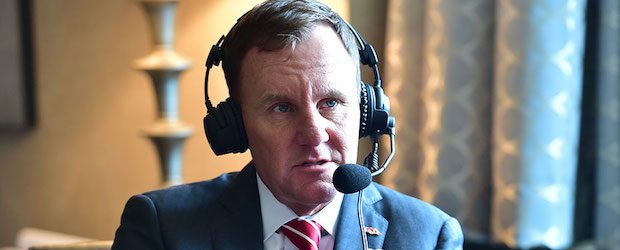
When Arkansas fans criticize the play-calling in last Saturday’s 31-17 loss at Ole Miss, they should also consider that at least four plays that night were well-designed and perfectly set up in the play script to result in touchdowns, if not for the Hogs’ poor execution.
So, maybe it would be fair for fans to shift their criticism from play-calling to whatever is happening on practice field, where one would hope the Hogs’ execution would have been ironed out before game time.
Remember these plays?
- Starting quarterback Ben Hicks underthrew running back Devwah Whaley in the right flat near midfield in the first quarter when Whaley had nothing but open space in front of him; Ole Miss’ pursuit had followed play flow and chased to the opposite side, and Hicks had Whaley open opposite. Instead of a catch and score for 58 yards, Whaley had to stop and retreat to field the underthrow, and Ole Miss was able to get to him rather quickly at the Rebels 48. Arkansas punted from midfield three snaps later.
- Hicks and Whaley had another chance to connect, this time late in the first half when the Hogs showed some life, trailing 10-3. This call, another perfect design, had the back running a vertical post with the Hogs’ other receivers in routes more to the mid-level area. It’s a route Texas Tech and Patrick Mahomes exploited on Bret Bielema’s Hogs in 2015 when Arkansas’s linebacker covering the speedy Tech running back could not keep up. Whaley was open down the middle; the ball was well over his outstretched fingers, however. Arkansas wouldn’t even get a field goal on that last possession of the half, as Connor Limpert had a uncharacteristically shaky night (his made field goal earlier hit the right upright but fell over the crossbar).
- Nick Starkel, Hicks’ replacement in the second half and the quarterback that 95 percent of the fan base wants to see start now (a number based on a THV11 poll immediately after the Ole Miss game), threw to the wrong side/wrong receiver on a planned “double pass” in the third quarter, this according to Hog coach Chad Morris. Starkel should have passed to the right wideout, freshman Treylon Burks, who was taking three steps behind the line of scrimmage. Burks has the arm and accuracy; he showed it at times for Warren playing both receiver and “wildcat” quarterback positions in his 2-plus years starting for the Lumberjacks. However, Starkel threw to the receiver on the left side, sophomore Mike Woods, who was as shocked as anybody that the ball had come to him. Woods had begun heading downfield, so he couldn’t legally throw a second forward pass, even if he retreated behind the line, to the wide-open C.J. O’Grady, a tight end, streaking down the field. O’Grady was all alone looking over his right shoulder expecting for the ball from Burks. Woods, meanwhile, panicked and began running around like a Pop Warner player, eventually surrendering 14 yards as the fast Rebel defenders were all over him.
- Even with that demoralizing fiasco, Starkel brought the spark to the Hogs’ passing game that Morris so badly needed, and two plays later he and Trey Knox combined on a 38-yard catch and run to tie the game – wait, there was a flag down. Burks, as the wideout on the right, had lined up on the line of scrimmage and “covered up” the tight end, Grayson Gunter, who also ran a pass route. Gunter had become an illegal receiver downfield. In Burks’ defense, he was freshman playing in front of nearly 48,000 fans on the road for the first time in his life (in 2008 at Kentucky, Joe Adams and other Hog freshmen receivers drew at least four illegal formation penalties). Maybe you’d hope, in this case, an experienced quarterback would notice the alignment problem and wave Burks back off the line before taking the snap, and the veteran Hicks might have done that, but he was now on the bench.
Still, those were all great designs that flopped due to execution. Any one of those plays going for a touchdown changes Arkansas’s attitude about winning this game in hostile surroundings, the confidence soars. Instead, the Hogs plodded through four quarters offensively – it seems like this has been the case since Chad Morris and Co. first arrived.
Bobby Petrino, appearing before the Little Rock Touchdown Club on Monday at a downtown hotel ballroom, recalled several stories from his four years as Razorback coach, and one illustrated his amazing attention to detail that provided his program with a winning edge (21-5 his last two years, 34-17 overall): The game-breaking fourth-down touchdown pass from Ryan Mallett to Joe Adams in 2010 vs. LSU, a 31-23 win in Little Rock that sent Arkansas onto the BCS Sugar Bowl against Ohio State, was the result of detail and practice that dated back to the previous spring.
Petrino noted Monday that he and his staff had picked up something in the previous year’s LSU matchup: In similar down-and-distance for a medium yardage fourth-down call, LSU would play its safeties “at the sticks” meaning even with the first-down marker. In this case, defending this day was the precocious youngster who a year later would become the acclaimed “Honey Badger,” Tyrann Mathieu. Joe Adams clicked his feet before finishing his double move on the safety; if the safety did something unexpected and dropped beyond the first-down line, Mallett would hit Adams there. If the safety maintained his spot at the sticks, Adams was by him in a flash. Mathieu froze, and Mallett hit Adams stride for a 39-yard scoring pass that pretty much finished that game.
Forget all the great designs, as we know Petrino had a file cabinet full of them. It was the attention to detail that amazed observers (and no doubt frustrated many players, who nevertheless played above beyond their perceived capabilities because of the coaching) during Petrino’s four years as UA head coach. And, in this case, running that same play for months on end, knowing maybe you might see the scenario again at the end of November, then it comes to pass and sends you to New Orleans? That’s a prescience that exceeds most football coaches’ abilities.
The media sees little if any of Chad Morris’ practices, whether in spring or in August or week to week during the season. Who knows what level of detail he and his staff apply to everyday activities and whether it’s in the ballpark of previous Hog coaches like Petrino and Lou Holtz? Morris, when he took the Arkansas job, brought an awfully young and collegiately inexperienced staff from SMU for the offensive side, while he turned the defense over to a mostly SEC veteran crew led by John Chavis. Fourteen games into his UA tenure, Morris still deserves trust from supporters that he’s been around big programs (Clemson) and knows good coaches, and that he made quality hires to assist him.
All we can tell from 14 games so far is, if you toss aside the current trope that the talent level left him was poor, it appears Morris and his staff’s attention to detail severely lacking on the offensively side and with special teams. You don’t dream up installing a surprise WildHog formation for Ole Miss, with weeks to prepare, and it look so feeble, or try to pull off an assortment of trick plays (including some mentioned above) and fail on all of them simply through lack of execution. It seems more like an attention to detail that falls way short – not just of a Bobby Petrino level, not just of an SEC coaching level, but of a college football level, period.
If this issue continues this week, Colorado State is good enough to beat the Razorbacks by two touchdowns.













